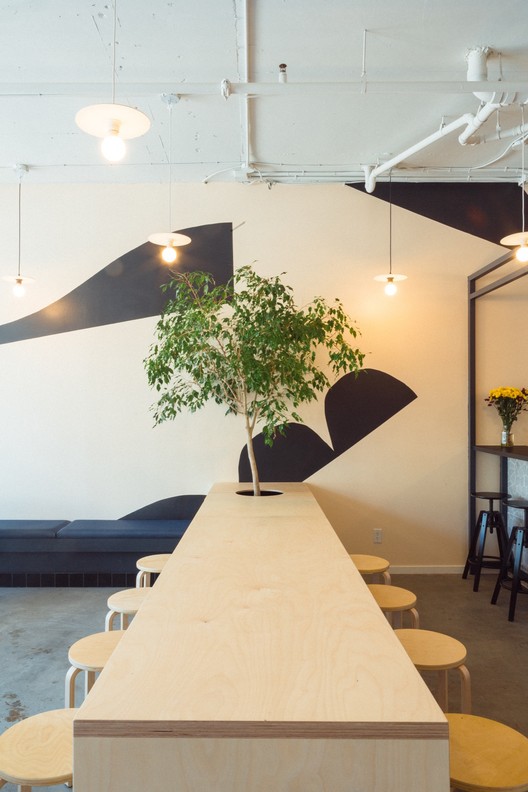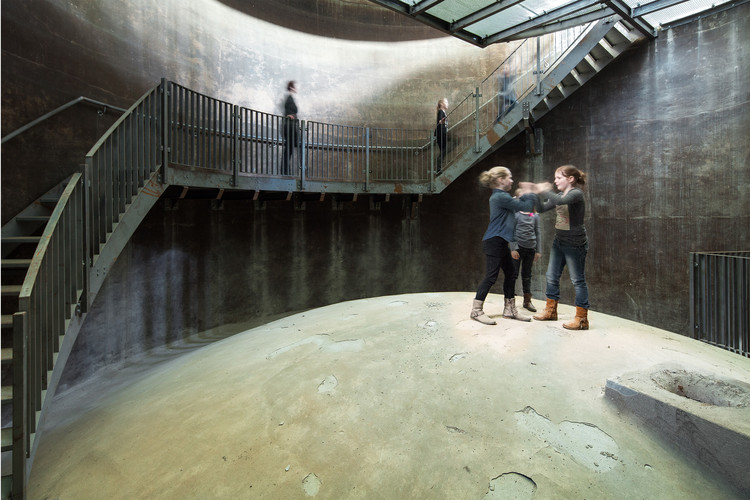Tsinghua Ocean Center OPEN Architecture
2017-03-20 08:00
© Iwan Baan
(Iwan Baan)


架构师提供的文本描述。清华海洋中心位于深圳西里大学城清华研究生院东端,紧靠校园正门,是清华大学新成立的深海研究基地的实验室和办公大楼。
Text description provided by the architects. Tsinghua Ocean Center, a laboratory and office building for the newly established deep-ocean research base of Tsinghua University, is located at the eastern end of Tsinghua graduate school campus in Shenzhen Xili University Town, and right next to the main campus entrance.
© Zhang Chao
张超


Axonometric


© Iwan Baan
(Iwan Baan)


即时大学城是中国近代城市化的缩影:远离市中心,这些孤立的城市群岛往往规模过大,缺乏人文关怀和相关服务。在设计海洋中心这个校园的最后一座建筑的机会下,我们希望这座新建筑能以前所未有的全新态度和可能性参与校园生活。这是一个开放和欢迎的氛围,而注入的公共空间鼓励所有的工作人员和学生参与和社交;这是一个智能的大脑可能会相遇,跨学科的交流自然发生的建筑。
Instant university towns are recent Chinese urbanization in epitome: far away from city centers, these isolated urban archipelagos are often over scaled, lack of humanistic concern and its related services. With the opportunity of designing Ocean Center, the last building on this campus, we hope the new building will participate in the campus life with a brand-new attitude and present possibilities that rarely existed before. This is a building with an open and welcoming atmosphere, while the injected public spaces encourage all the staff and students to participate and socialize; It is a building where intelligent brains may encounter each other and inter-disciplinary communication happens naturally.
Vertical Campus Design Concept
垂直校园设计理念


本设计以校园内公共空间的组织为出发点。这座建筑没有在规划中终止校园的主轴,而是将轴线折叠起来,向上延伸,沿途注入了丰富的公共空间。本文对传统的大学校园四种类型学进行了重新解释,形成了一个生动的垂直四元体系.同时,在这个垂直的校园里,研究中心之间的半自治而又相互依存的关系可以被想象出来-每两个研究中心之间都夹着一个共享的公共层次。会议室、头脑风暴区、展览空间、自修室、咖啡馆和其他设施都可以在这些共享的层次上找到。此外,在每个研究中心内,实验室和办公室被垂直间隔隔开,楼梯将不同的水平和垂直公共空间连接在一起。随着时间的推移,这些共享空间中的植物将繁茂起来,把地面上的绿色植物一直延伸到60米高的屋顶花园。屋顶花园有一个小型露天剧场,这将是校园内一个非常特殊的全景观景台,人们不仅可以欣赏远山的景色和天空的变化,还可以在不远的深圳野生动物园瞥见长颈鹿。
The design takes the organization of public spaces within the overall campus as a starting point. Instead of terminating the campus' main axis on the plan, the building folds the axis to extend it upwards, with abundant public spaces injected along the way. The conventional quad typology for university campuses is re-interpreted here, to form a lively vertical quad system. Meanwhile, the semi-autonomous yet interdependent relationship among the research centers can be visualized in this vertical campus - a shared public level is sandwiched in between every two research centers. Conference room, brain-storming area, exhibition space, study rooms, cafés and other facilities can all be found in these shared levels. Furthermore, within each research center, the labs and offices are separated by a vertical gap, with stairs connecting different horizontal and vertical public spaces together. As time goes by, the plants in these shared spaces will flourish and extend the greenery on the ground all the way up to the roof garden at 60-meter high. The roof garden has a small open air theater which will be a very special panorama viewing platform in the campus, where one may not only enjoy the views of distant mountains and changes of the sky, but also glimpses of giraffes in Shenzhen Wildlife Zoo not too far away.
© Zhang Chao
张超




© Zhang Chao
张超


在入口广场的下面,有一个深海研究池,这个中心最独特的实验室。三个混凝土锥形天窗将不同方向的自然光带到地下室,同时为进入广场形成抽象的雕塑。会议室混凝土墙壁上的圆窗让人想起了船舶的记忆.由德彪西(Debussy)根据“海洋”组织的露骨太阳镜,每天都以不同的角度演奏一曲轻音乐交响曲。公共楼层的蓝色浅色逐渐由浅色变为浅色,与不同深度的海洋不同。
Hidden underneath the entry plaza, there is a deep-sea research tank, the most unique lab of this center. Three concrete cone-shaped skylights bring natural lights from different directions down to the basement, while forming abstract sculptures for the entry plaza. Round-windows on the concrete walls of the meeting rooms recall the memories of ships. The brise soleil on the façade is organized according to “ocean” by Debussy, varying its angles to produce a symphony of light play every day. The blue soffit colors of the public floors gradually change from deep color below to lighter ones above, not unlike the ocean with different light appearances at different depth.
© Iwan Baan
(Iwan Baan)


建筑物的建筑语言来源于深圳当地的气候。丰富的半室外空间调节着建筑的微气候,而薄板坯类型则最大限度地发挥了自然通风的潜力。浓密和精心放置的外部遮阳装置有效地降低了热量,但仍然为实验室和办公室提供了良好的视图。在可能的情况下,采用被动策略来降低能源消耗。裸露的结构混凝土提供了一个长期和免维护的外部装修,与它的灰泥邻居直接对比。
The architectural language of the building is born out of the local climate of Shenzhen. Abundant semi-outdoor spaces regulate the micro-climate of the building, while the thin-slab typology maximizes the potential of natural ventilation. Densely and carefully placed exterior shading device efficiently cut down the heat gain, yet still offers good views for the lab and offices. Passive strategies are adopted whenever possible to lower the energy consumption. Exposed structural concrete provides a long-lasting and maintenance free exterior finish, in direct contrast with its stucco-ed neighbors.
© Iwan Baan
(Iwan Baan)




© Zhang Chao
张超


实验室所需的机械室和竖井,连同垂直结构核心,都安排在建筑物的两端,然后通过中央走廊的天花板将各种建筑机械系统水平地交付给不同的实验室。这种配置使研究层保持开放,并允许在需要替代未来更改的情况下进行灵活的重新分区。研究实验室是根据一个基本模块规划的。办公室和附属空间布置在附近,为科学家提供安静和方便。
The mechanical rooms and shafts required for the laboratories, together with the vertical structural cores, are organized at both ends of the building, which then delivers the various building mechanical systems horizontally through the ceilings of the central corridor to different laboratories. This configuration leaves the research floors open and allows flexible re-partition should alternative future changes be needed. The research labs are planned according to a basic module. Offices and ancillary spaces are arranged in vicinity, to offer scientists both quietness and convenience.
© Iwan Baan
(Iwan Baan)


























































































Architects OPEN Architecture
Location Shenzhen, China
Category Offices
Architect in Charge LI Hu, HUANG Wenjing
Design Team Victor Quiros, ZHAO Yao, ZHANG Hanyang, ZHOU Tingting, YAN Dihua, ZHOU Xiaochen, QIAO Shawei, ZHANG Chang, QI Zhengdong, Joshua Parker, CHEN Chen, Laurence Chan, JIN Boan
Project Year 2016
Photographs Iwan Baan , Zhang Chao































